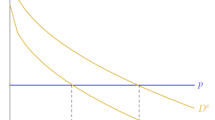Abstract
This paper investigates properties of the second best allocation in a fiscal federal system in which both federal tax and intergovernmental grants are involved and the taxation is distortionary. Also, optimal federal grants and tax policies in a decentralized fiscal system are examined. Our major findings are: (i) the second best does not require the equalization of marginal cost of public funds across regions in a conventional form; (ii) matching grants based on either the local tax rates or tax revenues should be introduced to internalize the tax externality; and (iii) once lump-sum and matching grants are optimized, federal tax policy becomes redundant so the optimal fiscal gap is indeterminate.
Similar content being viewed by others
References
Atkinson, B. A., and J. F. Stiglitz. (1980). Lecture on Public Economics. McGraw-Hill.
Auerbach, A. J. (1985). “The Theory of Excess Burden and Optimal Taxation.” InA. J. Auerbach and M. Feldstein (eds.), Handbook of Public Economics I. North-Holland.
Boadway, R. W. (1982). “On the Method of Taxation and the Provision of Local Public Goods: Comment.” American Economic Review 72, 846-851.
Boadway, R. W., and F. R. Flatters. (1982). “Efficiency and Equalization Payments in a Federal System of Government: A Synthesis and Extension of Recent Results.” Canadian Journal of Economics 15, 613-633.
Boadway, R., and M. Keen. (1996). “Efficiency and the Optimal Direction of Federal-State Transfers.” International Tax and Public Finance 3, 137-155.
Boadway, R., M. Marchand, and M, Vigneault. (1997). “The Consequences of Overlapping Tax Bases for Redistribution and Public Spending in a Federation.” Journal of Public Economics, forthcoming.
Boadway, R. W., and D. E. Wildasin. (1990). “Optimal Tax-Subsidy Policies for Industrial Adjustment to Uncertain Shocks.” Oxford Economic Paper 42, 105-134.
Buchanan, J. M., and C. J. Goetz. (1972). “Efficiency Limits of Fiscal Mobility: An Assessment of the Tiebout Model.” Journal of Public Economics 1, 25-44.
Burbidge, J. B., and G. M. Myers. (1994a). “Redistribution Within and Across the Regions of a Federation.” Canadian Journal of Economics 27, 620-636.
Burbidge, J. B., and G. M. Myers. (1994b). “Population Mobility and Capital Tax Competition.” Regional Science and Urban Economics 24, 441-459.
Dahlby, B., and S. Wilson. (1994). “Fiscal Capacity, Tax Effort, and Optimal Equalization Grants.” Canadian Journal of Economics 27, 657-672.
Dahlby, B. (1994). “The Distortionary Effect of Raising Taxes.” In W. B. P. Robson and W. M. Scarth (eds.), Deficit Reduction, What Pain, What Gain? C. D. Howe Institute.
Dahlby, B. (1996). “Fiscal Externalities and the Design of Intergovernmental Grants.” International Tax and Public Finance 3, 397-412.
Flatters, F. R., J. V. Henderson, and P. M. Mieszkowski. (1974). “Public Goods, Efficiency, and Regional Fiscal Equalization.” Journal of Public Economics 3, 99-112.
Gilbert, G., and P. Picard. (1996). “Incentives and Optimal Size of Local Jurisdictions.” European Economic Review 40, 19-41.
Gordon, R. H. (1983). “An Optimal Taxation Approach to Fiscal Federalism.” Quarterly Journal of Economics 98, 567-586.
Johnson, W. R. (1988). “Income Redistribution in a Federal System.” American Economic Review 78, 570-573.
Lin, H. (1995). “Public Goods, Distortionary Taxation and Perfect Household Mobility.” Mimeo, Queen's University.
Mansoorian, A., and G. M. Myers. (1993). “Attachment to Home and Efficiency Purchases of Population in a Fiscal Externality Economy.” Journal of Public Economics 52, 117-132.
Mansoorian, A., and G. M. Myers. (1997). “On the Consequence of Government Objectives for Economies with Mobile Populations.” Journal of Public Economics 63, 265-281.
Myers, G. M. (1990). “Optimality, Free Mobility, and the Regional Authority in a Federation.” Journal of Public Economics 43, 107-121.
Smart, M. (1998). “Taxation and Deadweight Loss in a System of Intergovernmental Transfers.” Canadian Journal of Economics 31, 189-206.
Stiglitz, J. F. (1982). “Self-Selection and Pareto Efficient Taxation.” Journal of Public Economics 17, 213-240.
Wellisch, D. W. (1994). “Interregnal Spillover in the Presence of Perfect and Imperfect Household Mobility.” Journal of Public Economics 55, 167-184.
Wellisch, D. W., and D. E. Wildasin. (1996). “Decentralized Income Redistribution and Immigration.” European Economic Review 40, 187-217.
Wildasin, D. E. (1983). “The Welfare Effects of Intergovernmental Grants in an Economy with Independent Jurisdictions.” Journal of Urban Economics 13, 147-164.
Wildasin, D. E. (1994). “Income Redistribution and Migration.” Canadian Journal of Economics 27, 637-656.
Rights and permissions
About this article
Cite this article
Sato, M. Fiscal Externalities and Efficient Transfers in a Federation. International Tax and Public Finance 7, 119–139 (2000). https://doi.org/10.1023/A:1008709203069
Issue Date:
DOI: https://doi.org/10.1023/A:1008709203069




